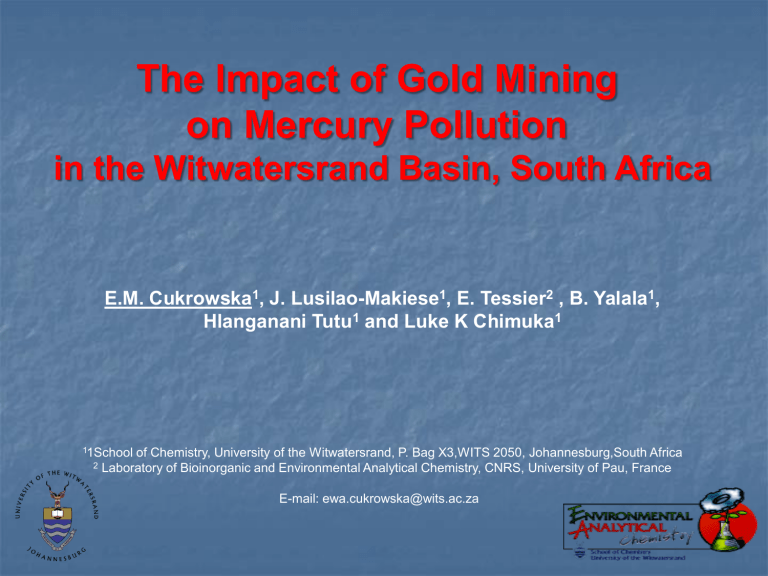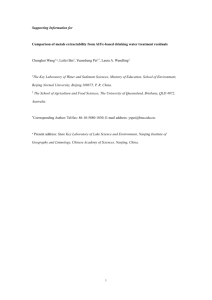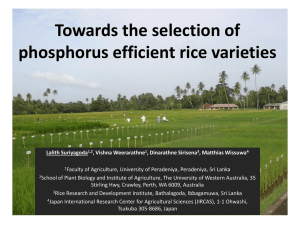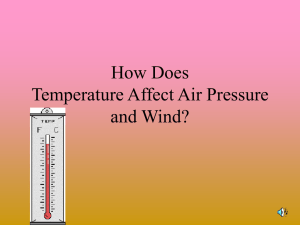Application of the Hyphenated GC

The Impact of Gold Mining on Mercury Pollution in the Witwatersrand Basin, South Africa
E.M. Cukrowska 1 , J. Lusilao-Makiese 1 , E. Tessier 2 , B. Yalala 1 ,
Hlanganani Tutu 1 and Luke K Chimuka 1
1 1School of Chemistry, University of the Witwatersrand, P. Bag X3,WITS 2050, Johannesburg,South Africa
2 Laboratory of Bioinorganic and Environmental Analytical Chemistry, CNRS, University of Pau, France
E-mail: ewa.cukrowska@wits.ac.za
In South Africa (SA), the largest anthropogenic point sources of mercury emissions are combustion sources followed by gold mining activities (reprocessing of old tailing dams and artisanal mining).
In the year 2000, South Africa was ranked 2nd in the world for total Hg emissions and 4th for Hg emissions arising from stationary fossil fuel combustion (Pacyna et al., 2006), though recent studies critically revised previous emission inventories.
Trend of global anthropogenic emissions by region based on Pirrone et al. (1996) (a) , Pacyna et al. (2003)
(b) , Pacyna et al. (2006) (c) , and Pirrone et al. (2010)
(d) . Data reported in Fig. d) are for most contributing countries. AF-Africa; AS-Asia; EU-Europe; NA-North
America; OC-Oceania; SA-South America.
The mercury speciation
ABSORPTION
BIOAVAILAVILITY
METHYLATION
TOXICITY of Hg depends on its….
chemical form
Total elemental analysis is not enough to provide such information
Research motivation and objectives
Motivation:
Most of the data on mercury in SA concerns total Hg determination only and mostly from coal fired power stations.
There is a need for measured speciation data near sources of concern, in order to get a better quantitative understanding of Hg chemistry in the SA semiarid environment
(atmosphere, soils, water bodies and biota).
Objectives:
Development, optimization and validation of reliable analytical methods for the determination of mercury species in different environmental matrices (air, water, sediments and biological materials).
Assessment of the extent of Hg contamination from historic gold mining sites i.e. to characterization of specific “hot spots” and to determination of Hg
TOT
, IHg and MeHg in water, soil, and biota.
To use obtained data for understanding the biogeochemical speciation of Hg, its distribution, transport and fate in environmental compartments impacted by mineral processing and energy production in South Africa.
Hg contamination from active gold mining sites
Sampling locations
Sediment, water and plant samples were collected near TSFs and in watersheds from goldfields within the Wits Basin.
A pilot study was carried out on a few collected air samples from a closed ventilation shaft
(Vaal River site) in order to assess the level of atmospheric Hg emission.
Dust samples were collected from
Greater Johannesburg area.
Speciation of Hg in sediment cores: sample preparation procedure
Derivatization
1 μl of organic phase
Sampling
GC-ICPMS
Freezing (~18
C) and Dissection
Spiking
Data acquisition
Freeze-drying and Grinding
Microwave
Assisted
Extraction
Case 1: Vaal River West Complex: a. sediments
US EPA Threshold Effect Level (TEL) value for Hg in sediment: 174 ng g -1
120 – 1000 ppb from dry to rainy season
950 – 220 ppb from dry to rainy season
8345-1500 ppb
From dry to rainy season
0.005-1.000 ppb in H
2
O
From dry to rainy season
Remobilization of Hg from the water dam to surrounding sediments.
4200ppb
Methylmercury formation
Methylation occurs at deeper layers in sediments.
MeHg enrichment in the region of high IHg and low redox.
There is a risk for MeHg to enter the water system!
Gaseous Hg (TGM) measurements in air samples from the ventilation shaft
High TGM concentrations at the outlet of the ventilation shaft
Typical background TGM in pristine and open areas:
1 - 4 ng m -3 (Wangberg et al., 2008)
TGM within urban areas: up to 15 - 25 ng m -3
(Wang et al., 2007)
The obtained TGM concentrations are likely to trace an underground gaseous Hg source from the old mine shafts connected to the ventilation shaft.
Case 2: Hg contamination from historic gold mining sites
Krugersdorp
Game Reserve
Mining Area
High Hg concentration in sediment and water!
Hg concentration much higher within the mining site than in the Game reserve
West Rand Hg
TOT
3000
2500
2000
1500
1000
500
0
80A 86A 87 92 93 95 97 98 100 105 106
Hg speciation in Randfontein sediment
West Rand sediments
2000
1500
1000
500
0
86A 87 92 93 97 98 100
IHg
10 x MHg
16
20
8
12
0
0,3
4
16
20
8
12
0
0
4
93
%MHg
%MeHg
1 2
93
%S
%S
0,45 0,6
3
0,75
8
12
16
20
0
0,15
4
16
20
8
12
0
1200
4
93
IHg ( μg kg -1 )
2200 3200
0,3
93
%C
%C
0,45 0,6
Correlation with
Suphur and Carbon
Hg in water samples: Typical case of AMD
Hg speciation in borehole water
Methylation occurs in deep water
(reducive conditions) but, due to its mobility, MHg migrates to shallow levels.
Case 3: Characterisation and modelling of mercury speciation in urban air affected by gold mining - assessment of bioavailability
(pilot study)
Investigations of atmospheric mercury have been mostly done on gaseous species. Although, to assess human expose to mercury, especially in urban areas, the inhalable dust should be included in a study.
The aim of this study was to determine the magnitude of mercury pollution in this urban area and assess its bioavailability.
Dust samples were collected on inhalation levels (1-2 m above a ground). They were later separated into different fractions by micro sieving.
Bioavailability of mercury in inhalable dust (25 µm) was tested by leaching collected samples with artificial lung fluid (ALF, pH 4.5), Gray’s solution (pH 7.4) and water. The leaching conditions were selected to mimic lungs environment (incubator at 30 0 C, time 24 hrs, rotation of samples 150 rpm). Total concentrations of mercury in dust fractions were also determined after microwave digestion.
Sample Analysis
Hg
TOT in dust was determined, after
MW digestion, by Anodic Stripping
Voltammetry with a gold rotating disc electrode (ASV-RDE)
Chemical
Phosphoric acid
Sodium chloride
Ammonium chloride
Sodium dihydrogen phosphate
K-acid-phthalate
Calcium chloride
Sodium acetate trihydrate
Sodium bicarbonate
Sodium citrate
Sodium carbonate
Sulphuric acid
Glycine
Citric acid
1.200
2.300
5.300
1.700
Magnesium chloride
Potassium chloride di-sodium hydrogen phosphate
Sodium sulphate anhydrous -
-
-
-
0.200
0.290
0.580
2.300
0.590
0.630
0.510
0.450
0.420
Gray's solution
(g L -1 ) pH 4.50
artificial lung fluid
(ALF)
(g L -1 ) pH 4.50
-
-
-
6.0193
0.2771
0.9526
2.6042
0.0970
-
-
-
-
0.2033
0.2982
0.1417
0.0710
Composition of lung leaching solutions
Total mercury in dust
+20 km
Sandton
22 ± 1 µg kg -1
Northern Residential Area
Cemetery
2011 ± 327 µg kg -1
CBD North
59 ± 6 µg kg -1
CBD
111 ± 9 µg kg -1
Tailings footprint
2081 ± 165 µg kg -1
Soweto
1575 ± 213 µg kg -1
Reprocessed tailings
3196 ± 133 µg kg -1
Mineral processing plant
1037 ± 36 µg kg -1
Soccer City
954 ± 124 µg kg -1
Industrial area
1102 ± 98 µg kg -1
Industrial area
1177 ± 91 µg kg -1
Mining & Industrial Area
Southern residential
466 ± 26 µg kg -1
PPC cement
2265 ± 71 µg kg -1
> 2000 µg kg -1
2000-1000 µg kg -1
100 – 999 µg kg -1
<100 µg kg -1
Dust samples leaching results
Bulk – Coarse dust
Sample ID Hg
TOT
( µg kg -1 )
Gray’s Solution
(µg kg -1 ) %
ALF
( µg kg -1 ) %
H
2
O
( µg kg -1 )
N3 fly over 37.86
± 4.32
26.77
± 1.14
71 23.43
± 0.60
61.9
15.10
± 1.35
RCS entrance 28.71
± 1.05
20.70
± 1.05
72 17.31
± 0.67
60.3
11.07
± 3.01
RCS exit
De Korte Str.
Smit Street
15.26
± 3.57
11.48
± 1.6
75 9.86
± 3.15
64.6
7.79
± 0.52
6.07
± 1.15
4.87
± 0.3
80 4.09
± 1.73
67.3
3.23
± 0.55
6.11
± 1.80
4.92
± 0.6
81 4.22
± 1.16
69.1
3.25
± 0.60
(Mean ± % Standard deviation)
Detection Limit: 6.24 ng L -1
< 25 µm particle size fraction
Sample ID
De Korte Str.
Smit Street
Hg
TOT
(
µg kg -1 )
Gray’s Solution
(µg kg -1 ) %
ALF
(
µg kg -1 ) %
N3 fly over 22.77
± 3.10 14.31 ± 7.03
63 10.86
± 2.15
48
RCS entrance 20.20
± 3.29 16.84 ± 7.12
83 13.76
± 5.86
68
RCS exit 11.12
± 4.57
8.24
± 1.85
74 7.18
± 2.12
65
4.40
± 1.56
3.46
± 1.34
79
4.34
± 2.14
3.02
± 1.14
70
3.04
± 4.15
69
2.77
± 1.52
64
(Mean ± % Standard deviation)
Detection limit: 7.11 ng L -1
H
2
O
(
µg kg -1 )
9.32
± 1.31
7.89
± 1.19
5.76
± 0.83
2.18
± 1.10
2.18
± 0.77
Summary
The extremely high Hg concentrations found in water and sediment suggest that post-goldmining activities may be important contributors of Hg to watersheds through probable remobilization that might occur at specific hot spots on a seasonal basis.
Localized point sources of Hg likely exist throughout the entire gold mining region.
Methylation of Hg is occurring close to the sources, which can allow MeHg to enter the food web.
These point sources offer the most treatable target areas for investigation of possible remediation projects.
TGM determination has shown a probable underground pollution source. Although, further air sampling in both shafts and open sites is needed to confirm these preliminary results.
Extremely high concentration levels of mercury was found in air and dust in industrial areas.
Especially high levels were detected around presently reprocessed old gold tailings dumps.
The levels dropped significantly in CBD area but still showing elevated concentrations. They depend strongly on prevailing wind directions, dry and wet seasons, and day time.
Leaching experiments showed that the Gray’s solution extracts more mercury from the dust followed by ALF and much lower by water. This suggests that most of the mercury inhaled with dust will be extracted in the deep interstitial parts of the lungs. In the upper region of lungs extraction will occur to a lesser extent.
Acknowledgement s
I. Weiersbye (APES, Wits University)
NRF (South Africa)
THRIP (South Africa)
Anglo Gold Ashanti (South Africa)









